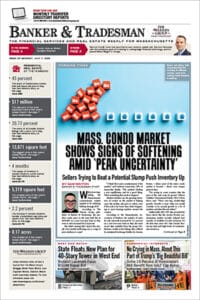
Buyers and sellers, both concerned about the economy for different reasons, seem to be causing condo inventory to build up. iStock illustration
With prices stagnating, the Massachusetts condominium market appears to be softening halfway through 2025.
According to The Warren Group, publisher of Banker & Tradesman, the median condo price in the state held flat at $550,000 on a year-over-year basis in May even as sales increased by 4.4 percent.
But what’s causing this? And is this simply a hot market mellowing out, or a sign of price declines to come?
“I think this is just a readjustment of the market,” said Anthony Lamacchia, CEO of Lamacchia Realty. “The market’s finding a new equilibrium, and it’s a good thing. That’s something that needs to happen.”
Market-watchers say the growing inventory of condos on the market is helping cause the median sale price to soften, even if the scale is far lower than what’s happening to most housing markets around the country.
According to the Massachusetts Association of Realtors, the number of units for sale statewide increased by 13.1 percent on a year-over-year basis in May, the most recent data available from the group. Preliminary weekly active listings data collated by residential brokerage Redfin for Greater Boston – where most of the state’s condo market is located – shows even steeper gains in June.
“I’m seeing in some counties that the price is flat, and some it’s grown,” Gibson Sotheby’s International Realty CEO Coleen Barry said. “There isn’t big, double-digit growth. Growth is more what you would consider to be normal growth in a lot of markets, and then flat and others.”
Additionally, MLS PIN data provided by Barry shows that the Greater Boston condominium market recently eclipsed four months of available for-sale inventory. It’s the first time since 2011 that Greater Boston has had such high levels of condominium inventory.
“This is actually a national condition that’s really happened over the last three weeks or so,” said Jonathan Miller, a real estate analyst and president and CEO of major appraisal firm Miller Samuel Inc. “We’re seeing a noticeable jump in inventory everywhere and that is causing the growth rate of prices to ease a bit.”
Buyers Pulling Back, Sellers Rushing In
With so little new development in Greater Boston, this build-up in inventory is coming from existing homes hitting the market – and staying there, unsold.
“Mortgage rates are seemingly stuck straddling 7 percent,” Miller said. “With all the tariff tantrums coming out of Washington and confusion with the consumer over the direction of the economy, we have people pulling back. The way I think of the market conditions right now is that we’re at peak uncertainty.”
Consumers are holding back on purchases unless certain situations deem it necessary such as relocation or finding a place to live after selling a previous property, Barry said.
“Some of what we might be seeing could have to do with the tariffs and ultimately, the stock market volatility,” she said. “Any sense of uncertainty causes people to hit the pause button.”
That uncertainty could be what’s driving an unusually high number of sellers to bring their homes to market.
“I think people are saying, ‘I better list now, while I can get what I can get for my home before the market tanks,’” said Maria Salzillo, a vice president and Realtor at J. Barrett & Company. “Everybody’s been saying we have to see some relief in these prices, and I think that they’re realizing that this is their opportunity and they better jump on it now.”
Poorly Priced Properties
Salzillo also noted that along with the flattening of median condominium sale prices, price cuts are becoming more common. When a market changes quickly it becomes harder for home sellers to price their property accurately, if they don’t want it to sit on the market.
“When properties start to sit a little bit longer, you start seeing price reductions,” she said. “That’s telling you that something’s happening in the market. One or two here and there, you see a price reduction over then the property wasn’t priced appropriately at the time. But when you see multiple price reductions or properties on market for over 20 days, because we were used to properties being on for three days, it starts to paint a picture for us.”
Monthly MLS data reported by listings portal Zillow showed that 20.73 percent of condominium and single-family listings, combined, had a price cut in May. That’s up from 16.85 percent in May 2024 and 13.33 percent in May 2023, but about even with the 20.78 percent with price cuts in May 2019.
Redfin data shows that only 45.2 percent of condos that sold in May traded above list price – the lowest since May 2020, in the early days of the COVID-19 pandemic.
“There have been some cases where we have seen a number of properties, pushing that upper level of what they think the market will bear, and then finding out that the market is not having an appetite for that,” said Sarah Gustafson, the 2025 Massachusetts Association of Realtors president.
Gustafson is also the operating principal at Keller Williams Pinnacle Central and Keller Williams Pinnacle MetroWest.
Luxury Units Could Be Vulnerable
According to The Warren Group, the largest number of Massachusetts condominiums sold in May for prices between $250,000 and $500,000. But sales of $1 million or more saw the greatest year-over-year increase.
The cost per square foot of condos is also increasing, Barry said, but not as fast as in prior years. MLS PIN data provided by Barry showed that in Greater Boston, the median price per square foot increased by 2.2 percent to $762.

Observers say Greater Boston’s luxury condominium market might be more vulnerable to price declines than the workaday market if uncertainty persists. iStock illustration
“The square footage price is growing, and it’s growing moderately,” Barry said. “In some cases, it’s 1 percent in other cases it’s more like 5 or 6 percent. It’s just happening at a more moderate pace – which, by the way, is normal.”
These increases in the median price per square foot indicate that the luxury market could be most affected by the softening market, Barry said, while the lower to middle sector of the market will likely continue to operate at levels previously seen.

Sam Minton
“The luxury end of the market had a little more of a struggle this year than it had in past years,” she said. “We were seeing that there was more inventory on the high end of the luxury end of the market, and that at the lower end of the market, things continue to truck along.”
In this environment, Gustafson said, sellers will need to focus on how to make their property competitive against the rest of the market.
“If you are in the higher end of the market and you’re starting to see longer days on market at certain price points, that’s when you’re going to want to have a conversation with your Realtor to say, what can you do be more competitive against the properties that are already out there, or what do you need to do to be more competitive to sell? That may result in an adjustment in order to attract those buyers in the lower to mid-price points, and we’ve noticed this across the state,” she said.
But while sellers might find this market stressful, it will be a good thing for buyers if these trends keep up.
“The buyers are starting to see this increase in inventory, which is something that many of them have not experienced before,” Gustafson said. “They’re waiting to see what else will happen, which is a little bit slower of a pace than they would have had a couple of years ago.”








